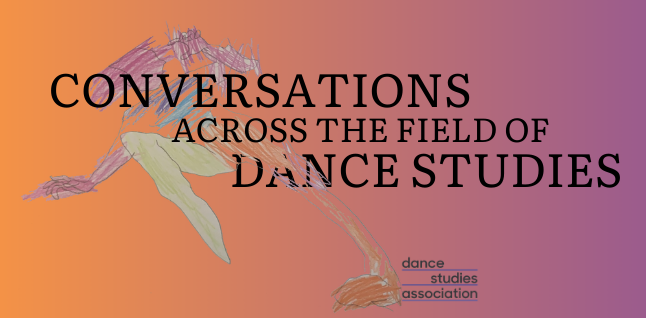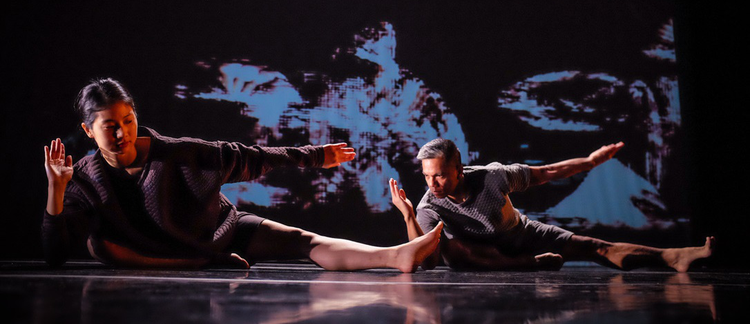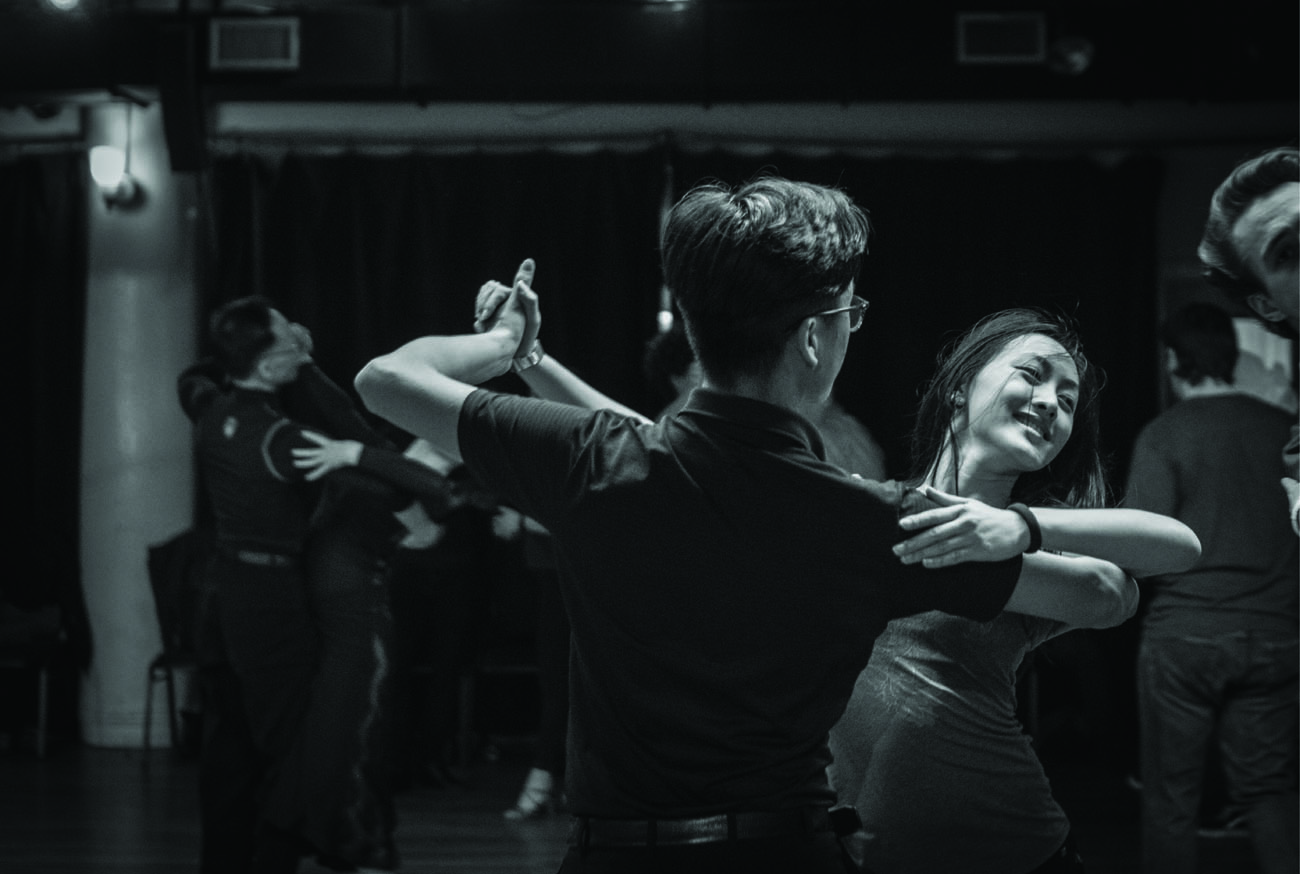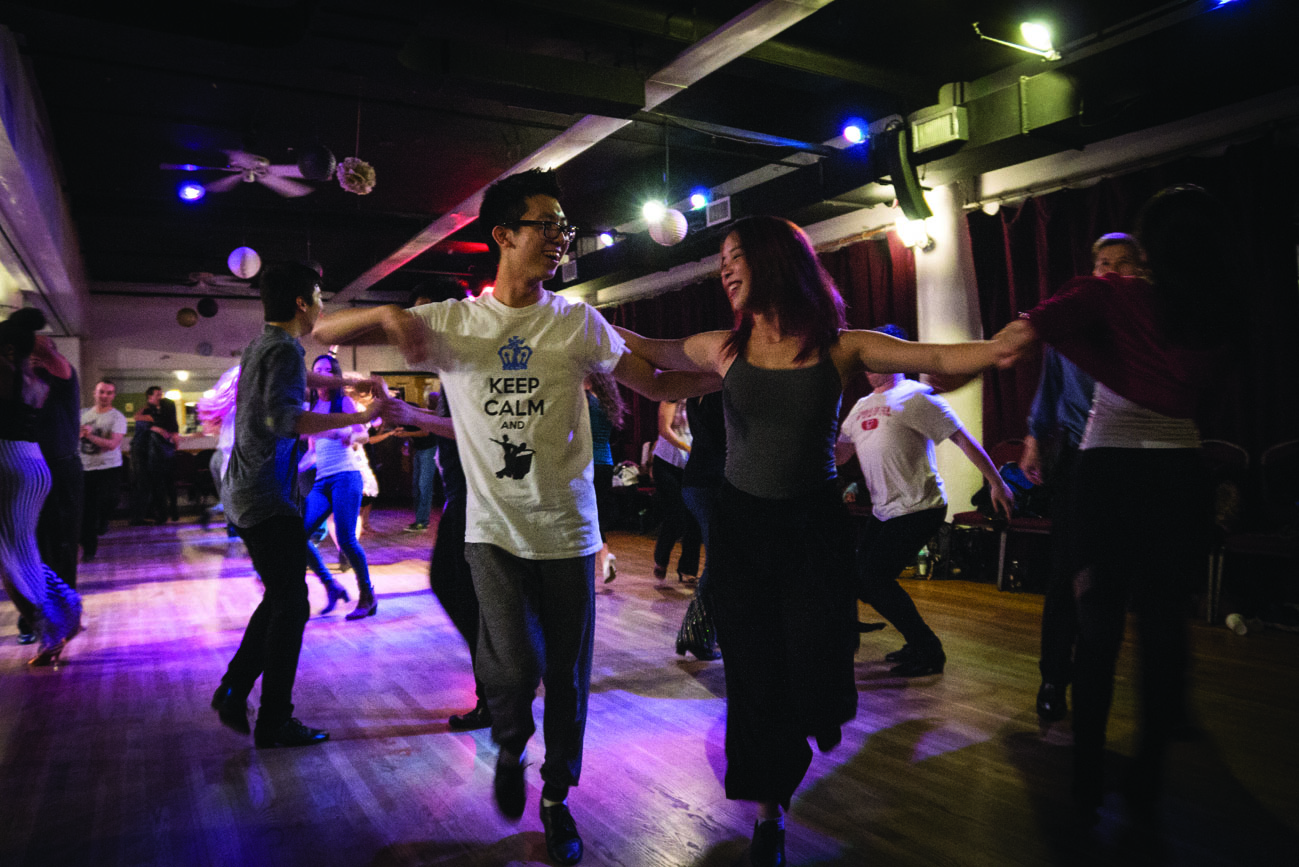Many people, especially those who have never done ballroom dancing, think that leading and following involves one partner acting and the other simply reacting, but it’s more like this: the lead indicates, the follow acts, the lead reacts, and so on with every step. No matter the song, the dance, or the space, our constantly shifting connection—from compression to extension, the structure of a full frame to the lightest grasp of fingertips—requires delicate responsivity on both ends. This sequence of atomized shifts in intention, the playful syncopation, the build-up to a snap and release of weight can all feel so good. It can also feel bad! I invite myself to be moved, and there is risk in this; there are partners who are inexperienced, inconsiderate, or just plain creepy. Still, I’ve always preferred following to leading. This isn’t unusual—many dancers say that they love getting to turn their minds off when they follow, though we all know this is not what it actually entails. Following is not about tuning out, but in, deeply, to myself and my partner and how we move together through the lively crush of other couples. Developing this practice has taught me so much about attending to my body, to its most expansive capacities and tender limitations.
I find it hard to talk about following with clarity and honesty—not only because, as I will argue, the practice itself maintains a certain eloquent ambivalence, but because what I’m sharing here can feel hazardous to admit. Within the ballroom world, the politics of pleasure have always been fraught, especially for those of us who have had to contest its terms of belonging, or carve out small corners in which we can at least belong to each other. In moments of exhaustion, I often recall the consternation with which Vicki Harman opens The Sexual Politics of Ballroom Dancing: “Why do women (including myself) who are committed to gender equality also enjoy this form of dance? Is it a position that is sustainable upon closer examination?” And, given the constraint and submission commonly associated with following, why would women “want to visit, through dance, worlds in which they would not want to live?” (Harman 2019, 7).
As a queer Asian American woman, such questions can feel especially charged. In the past two decades, the population of Asian American ballroom dancers has come to constitute what George Uba calls a “critical mass.” In his article “From Signifying to Performance: International Ballroom Dance and the Choreographies of Transnationalism,” Uba offers several interpretations of this ardent participation. Does it hint at the potential to resignify a Eurocentric practice, or is it merely a means for these dancers to shore up their privileged proximity to whiteness? Uba is especially concerned with how these questions come to bear on the troubling figure of the Asian female follow: “Like the feminized body of the colonized nation, the woman passively awaits the male imperative” (Uba 2007, 150). To probe the instructive force of following, then, can be a move that feels, to borrow Anne Anlin Cheng’s phrase, “counterintuitive or even dangerous” (Cheng 2019, 85). This sense of theoretical risk carries material weight as well. During my eight years in the East Coast collegiate and amateur ballroom communities, I have heard countless women and queer dancers, especially those of color, share experiences of being excluded, exploited, and otherwise diminished in these spaces. That such experiences are often trivialized or silenced within a community that prides itself on the openness and inclusion of partner dancing seems all the more malicious in a moment when—as the past two years have made clear—Asian women, in particular, must navigate a perilous existence defined by our “degraded availability” (Cheng 2021).
The things I love most about following—the intimacy we share with our partners, the pleasures of self-fashioning through performance—can also be its most precarious and tiresome balancing acts. These very qualities are taken by men as carte blanche to make presumptions about our amenability, to flirt with (often much younger) mentees or students, to let hands wander during a dance, to commit acts of harassment and violation that they later refuse to countenance as such. Ballroom, for all its emphasis on trust and respect between dancers, has never transcended these ugly dynamics. Yet I would also hesitate to designate it, in Harman’s words, a world I have a perverse desire to visit but in which I would not want to live, as though the non-dance world has progressed beyond such perversities.
Instead, I offer the contours of a conversation on the practice of following in relation to the lived, embodied textures of Asian femininity, in order to ask what more livable worlds this form of dance invites us to imagine. “Ballroom is what makes me feel free,” my friend Paggy told me in an interview (Zhu 2019, 6). One thing this essay tries to do is parse the complexities of Paggy’s concise invocation of following as freedom. What could be freeing about a practice that fundamentally entails some degree of submission and surrender? How might our participation as Asian American women be an always already vexed endeavor, especially when our visibility and vulnerability—even as gifts freely given—cannot be divorced from the specter of violence?
This is not, then, an argument for reclaiming agency or pleasure for Asian American follows per se, nor for redeeming ballroom from its role in structuring hegemonic categories and relations—especially those that drive the forms of racialized misogyny we are seeing in full force. To speak of freedom here is not to ignore these issues, nor to release scholars and dancers from our accountability to them. Rather, I want to offer a different perspective on following, one that emerges from daily embodied practice, staying with its contradictions—much as a skillful partnership knows how to use and sustain tension as an integral piece of connection—rather than seeking to resolve them. As such, this approach departs from the framings of lead and follow offered by other scholar-practitioners—for instance, Juliet McMains’s contention that leading is “ultimately a more powerful position” with “much greater control” within the partnership (McMains 2006, 29), but also Harman’s reformulation of following, which aims to refute its associations with passivity, as “active” and “genderless” (Harman 2019, 155). In asking what following might mean and do for Asian American dancers, who occupy a particularly vexed and yet understudied position within such debates, I argue that following is neither inherently disempowering nor in need of recuperation to be personally and politically viable.1
Likewise, attending to the complexities of this position helps us complicate the popular notion that partner dancing has the power to collapse “distinctions between self and other” (Lawrence 2009, 4), to “dissolve the actual and the ideal, the shared and the individual, into a singular rich and moving experience” (Bosse 2015, 4). The dancers I discuss and am inspired by here do not aspire to efface difference, reflecting instead SanSan Kwan’s contention that “dance can make visibly and viscerally manifest the effortfulness of collaboration, the satisfaction in moments of unison, and also the exquisite persistence of our unique, sovereign selves” (Kwan 2021, 14). Partner dancing, by default, does not protect our sense of autonomy. It is premised on being in relation to others—sometimes with practiced, easy intimacy, but just as often in contingent and unpredictable ways. Rather than offer access to a whole, discrete, and authentic self, it prompts us to ask: what kinds of self in relation, or self as relation, are forged through dependence and surrender?
Illuminating the embodied complications of agency, pleasure, and other such “politically treasured notions” (Cheng 2019, 14), following is one productive site on which an Asian American feminist politics can be theorized and practiced. It demands a different kind of attention and enables a different set of questions: out from the cul-de-sac of why we do this and whether it is sustainable, toward the more generative terrain of what it means to us and how these meanings are managed and contested. In the interviews I conducted with Asian American follows, they voice anxiety, chagrin, frustration, and refusal in response to being caught in that cul-de-sac. They recall being repeatedly told—by other Asian Americans—that any sense of joy, challenge, or community they might experience in ballroom is not only illegible but also politically suspect, even compromising. “I remember my friends and people that I knew being super shocked that I was doing ballroom,” B shared, “because they’re like, that doesn’t seem like you at all. And I was like, what doesn’t seem like me, right? And they’re like, well, you don’t seem like the type of person who would just let someone move you, or listen to what other people want you to do.” They resist this reductive interpretation: “I’m still making decisions for myself … and telling my partners when something is wrong, or when something works well. I still feel like me. But I think there’s definitely an overall perception, where it’s like, the follows are powerless, or especially that Asian women are powerless” (Li 2019, 18).2
Such perceptions—as well as the judgments and misreadings of following they facilitate—are suggestive of what we might term an imperative to perform resistance. Viet Thanh Nguyen incisively names this impulse within Asian American cultural politics to idealize the “bad subject” who rejects hegemonic racialization outright (Nguyen 2002, 5). Many follows do not resist the ways in which ballroom strives to interpellate them into heteronormative whiteness per se, instead staking out more ambivalent stances that enable them to participate—and take pleasure—in this dance form while maintaining a sense of critical generosity toward it. In the process, they often confront the “ideological rigidity” Nguyen identifies as a consequence of valorizing resistance at the expense of our ability to access and attend to more “flexible strategies” (7). Hope, like B, recalled the surprise and skepticism she received from friends and family when she first joined ballroom, and how such responses assume that Asian women who enjoy ballroom are either submitting to unfeminist ideas or are predisposed toward compliance. In our interview, she suggested that by approaching ballroom as “a very deeply relational experience,” we might begin to imagine more capacious forms of relationality, ones that confound binary notions of agency and are premised on—rather than allergic to—vulnerability and interdependence: “I think when people say that they want to be strong, what they mean is that they never want to be weak. And that’s impossible. And I think ballroom has taught me that it’s okay to be a follow, you know?” (Chang 2017, 5).
Arlene, a seasoned world finalist, echoed these sentiments with more exasperation, observing that the tendency to empower women in ballroom by encouraging them to lead—or resignifying following as “active” while diminishing its other qualities—reproduces our “societal valorization of proactiveness” as a white, masculine property. “Just what is wrong with being receptive is beyond me,” she said in our interview. “I’m sorry, but where is it written we have to be completely consistent in every aspect of our lives? That’s exhausting. Can’t I like leading in one area and then being more receptive in another? Isn’t being able to do both being a whole human?” (Yu 2020). Indeed, it is through such inconsistencies, contingencies, and ongoing negotiations that Asian American follows expand our understanding of agency. “Following requires a kind of Zen—you don’t give up control, but you need to hang back and be receptive,” Arlene said. “Follows dictate plenty. They can shift the leader’s weight, affect timing of step completion and initiation of the next step, change the interpretation” (Yu 2020). Resistance of a kind is key here: not defiance per se, but moments of playful noncompliance, reserving some of one’s own weight and power—hanging back—to release at the right time, letting the connection stretch before snapping forward. This deliberate withholding—the practice of following as a well-timed refusal to follow—is essential to maintaining a lively elasticity between partners.
Danica termed this kind of exchange physically but also “really emotionally satisfying” (Chan 2018, 10). Like Arlene, she described the relationship between lead and follow as not defined by hierarchical, or even discrete, responsibilities—both dancers must attend to their shared and individual weight, using it “to create speed and shape and movement” (Chan 2018, 9). Danica is one of my favorite follows to watch and learn from; she knows how to play with rhythm, letting her head fall back at the top of a shape to accentuate the stretch, expanding the space between one phrase and the next. Her best and most memorable dances, she remarked, are successful because they turn on a constant give-and-take: it is crucial to feel like “we can control one another’s weight,” her partner offering clear indications so she can “take that lead and do something with it” (10).
While many think of ballroom as outward and ostentatious, especially compared to other partner dance forms, when I watch Danica dance, I’m equally drawn to the moments of expansive exuberance as those when her movement and gaze draw inward, away from the eager crowd of onlookers she and her partners often attract. Her body moves with such assurance and ease that the lack of eye contact doesn’t read as modest or tentative; rather, it evokes something of what Kevin Quashie terms the aesthetic and—echoing Kwan—the sovereignty of quiet. For Quashie, quiet summons “something finer” than resistance (Quashie 2012, 4); its performative force is not immediately evident. Surrender comprises one embodied mode of quiet, and while it is often assumed to connote passivity or defeat, it “can also be expressive and active,” a “falling toward what is deep and largely unknowable” (28). Partner dancing, and following in particular, activates the potential that Quashie locates in surrender. This subtle, joyous virtuosity may well offer a form of resistance—but more likely, we need another, finer word for it.
If there is freedom in following, then, it is the kind that Cheng terms “delicate and transitory” (Cheng 2019, 150), or that Danielle Goldman describes as not “devoid of constraint,” but animated by it—technical and stylistic as well as sociopolitical and historical (Goldman 2010, 3). To engage in a moment-by-moment negotiation with partner, space, and music—to navigate the dilemma of intimacy that partner dancing is with satisfaction and finesse—is not a contradictory but a constitutive endeavor, a vexed but generative mode of meaning-making. As Goldman argues, “To engage oneself in this manner, with a sense of confidence and possibility, is a powerful way to inhabit one’s body and to interact with the world” (5).
Quiet, receptivity, attentiveness—for Asian American women, these are undeniably racialized and gendered qualities, and they cost us something to cultivate. Both my best and worst performances as a follow will always dredge up for me this devastating line from Cheng about idealized Asian femininity and its diminishing returns: “It takes too much psychic effort to be always good and disciplined, constantly self-curating, and vigilantly tuned into the minefield of multiple consciousnesses” (Cheng 2020). Following, in one sense, demands precisely this kind of vigilance; the other face of its utopian promise is cruel optimism. Lauren Berlant defines this relation as one in which “something you desire is actually an obstacle to your flourishing” (Berlant 2011, 1), a fantasy that simultaneously sustains and drains us. Indeed, the pandemic’s shutdown of partner dancing provided time to consider how earnestly I embraced its imperatives as a younger dancer, how much pride I took in being deemed a “good follow.” Now, as the community recovers in fits and starts, I am struggling to tune back into that radiant, sensual, and self-assured persona that so many follows seem to have mastered. These days, it feels especially perilous to offer up my body for someone else’s appraisal or viewing pleasure. I want ballroom to love me as much as I love it, but it feels foolish to want such a thing after eight years of being told otherwise: by white men who joke that they joined to meet Asian girls, by respected coaches who label female leads and queer pairings “gender garbage,” by studio gossip that deems abusive partnerships and discriminatory insults par for the course.
This essay, then, is also about navigating these (dis)investments and leaning into what I know to be the life-giving parts of this practice. In March 2022, I attended the first Friday Night Fever ballroom social hosted in New York City since lockdown started two years before. Taking frame with each of my friends, I remembered how, for the first few months of sheltering in place, I’d dreamed about this moment every day—went for my little walks, alone and masked, listening to music and imagining the ways we’d move together again. As we return to daily practice, I want to offer a way of thinking about ballroom that isn’t strapped by the discourse of good or bad subjects, and that is better attuned to the psychic conditions— the contradictory and at times self-effacing desires—that constrain and animate the participation of Asian American follows. These perspectives on agency and pleasure do not attempt to transcend difference or erase injury; we hone our skills as follows in full recognition of their histories, risks, and complications. In refusing finalization, they offer us other options.
When I’m following, I’m reminded of how much good dancing is like good scholarship, each requiring a willingness to hazard risk and be humbled in the process. Shaped by—and in spite of—my experiences in both of these worlds, I remain hopeful about their possibilities. If following can be a form of worldmaking, then, it reflects José Muñoz’s investment in hope as “a critical affect and methodology” (Muñoz 2009, 4)—all the more urgent for its seeming insufficiencies. It reminds me that while this kind of hope, like the feeling of freedom, may indeed preclude—or at least precede—the clarity of political orientation our moment demands, it remains essential to sustaining and nourishing that orientation, in the face of incommensurable loss and difference, in the ways that matter most.
Notes
- In recent years, within the time in which my work is based, dancers have mounted significant opposition to and reimagining of the heteronormative partnership. As a queer dancer and organizer, these efforts have been deeply formative for my thinking. However, I focus here on women and nonbinary dancers who train as follows in order to parse the particular constraints at play in their performances of submission, surrender, and improvisatory negotiation. ⮭
- The interviews shared here have been edited slightly for clarity. All of the interviewees consented to share their full names, or in B’s case, their preferred shortened name. ⮭
Author Biography
Crystal Song is a PhD candidate in performance studies at the University of California, Berkeley. Her research explores the euphoric feelings that animate contemporary Asian American cultural politics, particularly in popular dance and media. She has been a member of the ballroom dance community since 2014.
Works Cited
Berlant, Lauren. Cruel Optimism. Durham: Duke University Press, 2011.
Bosse, Joanna. Becoming Beautiful: Ballroom Dance in the American Heartland. Chicago: University of Illinois Press, 2015.
Chan, Danica. Interview by Crystal Song. New York, January 7, 2018.
Chang, Hope. Interview by Crystal Song. New York, February 9, 2017.
Cheng, Anne Anlin. Ornamentalism. Oxford: Oxford University Press, 2019.
Cheng, Anne Anlin. “How Fashion Can Relieve Us from the Burden of Visibility.” Hyperallergic, January 28, 2021. https://hyperallergic.com/616945/how-fashion-can-relieve-us-from-the-burden-of-visibility/.https://hyperallergic.com/616945/how-fashion-can-relieve-us-from-the-burden-of-visibility/
Goldman, Danielle. I Want to be Ready: Improvised Dance as a Practice of Freedom. Ann Arbor: University of Michigan Press, 2010.
Harman, Vicki. The Sexual Politics of Ballroom Dancing. London: Palgrave Macmillan, 2019.
Kwan, SanSan. Love Dances: Loss and Mourning in Intercultural Collaboration. Oxford: Oxford University Press, 2021.
Lawrence, Tim. “Beyond the Hustle: 1970s Social Dancing, Discotheque Culture and the Emergence of the Contemporary Club Dancer.” In Ballroom, Boogie, Shimmy Sham, Shake: A Social and Popular Dance Reader, 199–214. Urbana: University of Illinois Press, 2009.
Li, B. Interview by Crystal Song. New York, May 16, 2019.
McMains, Juliet E. Glamour Addiction: Inside the American Ballroom Dance Industry. Middleton: Wesleyan University Press, 2006.
Muñoz, José Esteban. Cruising Utopia: The Then and There of Queer Futurity. New York: New York University Press, 2009.
Nguyen, Viet Thanh. Race and Resistance: Literature and Politics in Asian America. Oxford: Oxford University Press, 2002.
Quashie, Kevin. The Sovereignty of Quiet: Beyond Resistance in Black Culture. New Brunswick: Rutgers University Press, 2012.
Uba, George R. “From Signifying to Performance: International Ballroom Dance and the Choreographies of Transnationalism.” Journal of Asian American Studies 10, no. 2 (2007): 41–67.
Yu, Arlene. Facebook message to Crystal Song. June 25, 2020.
Zhu, Paggy. Interview by Crystal Song. New York, June 19, 2019.




